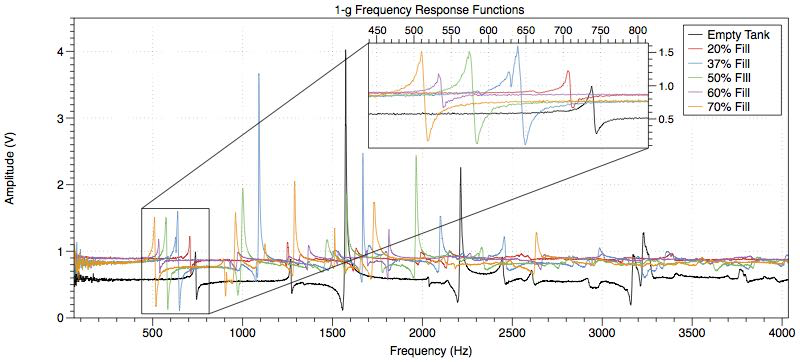Modal Propellant Gauging
The MPG project is a collaboration between Carthage Space Sciences and Kennedy Space Center Cryogenics Laboratory to develop a high-resolution low-gravity fuel gauging technology by exploiting the effect of fluid loading on the structural properties of liquid-filled propellant tanks.
Experiment Background

Experimental Modal Analysis (EMA) involves recording the vibration spectrum of a solid object and using the spectral characteristics to infer the structural properties of the object. The EMA technique requires that we stimulate all acoustic resonances in the tank structure by applying a broadband white noise signal. Tank response is measured at discrete locations on the surface of the tank and the Fourier Transforms of the response and input functions are computed in real-time. Finally, the Frequency Response Function (FRF) for each structural response is computed by essentially taking the ratio of the response FFT to the input FFT. The resulting FRF is a complex-valued function in which the real part is a function of the effective mass of the vibrating object and the imaginary part is related to the rate of energy dissipation through structural damping. Adding fluid to a tank lowers the real part of the frequency by increasing the effective mass. In addition, fluid in a closed tank changes the imaginary part of the frequency by damping the vibrations.
Carthage College’s Microgravity Team has been developing this method since a 2011 reduced gravity flight campaign under the NASA Systems Engineering Education Discovery (SEED) program. In 2012, the SEED team demonstrated that EMA is a promising fuel gauging method with a resolution of 10% of the total volume of the tank in the case of unsettled, sloshing liquid. Carthage’s 2013 RockSat-C team further tested the precision of this technique with an experiment on a sounding rocket launched from Wallops Flight Facility: the maximum resolution achieved was 1.5% in volume for fill fractions from 30% to 70% and 7.4% in volume between 0% and 20% fill fractions. A 2014 USIP/FOP flight campaign demonstrated a liquid volume resolution of 2.0% for fill fractions between 30% and 70% of total tank volume (unsettled, zero- g measurements). The 2015 NASA/FOP flight campaign achieved resolutions of 1.5% for sloshing propellant simulants at fill fractions between 20% and 60%.

Students Involved
Kimberly Schultz, Amber Bakkum, Stephanie Finnvik, Cecilia Grove, Erin Gross, Steven Mathe, KelliAnn Anderson, Danielle Weiland, John Robinson, Eli Favela, Kevin Lubick, Mikaley Osley, Seth Schofield, Daisy Bower, Eric Ireland, Kyle Weber, Ben Tillema, Kevin LeCaptain, Tessa Rundle, Ethan Woller, Nate Lee, Jackson Wehr, Megan Janiak, Sheila Franklin
Flight Campaigns
NASA SEED 2011, 2012, NASA USIP 2014, 2015, NASA FOP 2016, 2017.
Related Presentations
Reports and Publications
Modal Propellant Gauging: High-resolution and non-invasive gauging of both settled and unsettled liquids in reduced gravity, Crosby, K.M., Williams, N.J., Werlink, R.J., Hurlbert, E.A. Acta Astronautica (2019). ISSN 0094-5765. https://doi.org/10.1016/j.actaastro.2019.01.050
Modal Propellant Gauging in Low Gravity
Crosby, K.M., Rundle, T., LeCaptain, K., and Werlink, R., AIAA SPACE 2016, AIAA SPACE Forum, (AIAA 2016-5533)
http://dx.doi.org/10.2514/6.2016-5533
Microgravity Propellant Gauging Using Experimental Modal Analysis
Rundle, T., LeCaptain, K., Werlink, R., Crosby, K., Proceedings of the 2016 Next-generation Suborbital Researchers Conference, June 1-4, Broomfield, CO.
Experimental modal analysis of fluid volume in spacecraft propellant tanks in microgravity Mathe, S., Lubick, K., Crosby, K.M., Werlink, R., Proceedings of the 23rd Annual Wisconsin Space Grant Consortium (2013).
Zero Gravity Fuel Gauging Using Modal Analysis (Proceedings Abstract)
Crosby, K.M., Werlink, R., Mathe, S., Lubick, L., Proceedings of the 2013 Next-generation Suborbital Researchers Conference, June 3-5, Broomfield, CO.
Modal Evaluation of Fluid Volume in Spacecraft Propellant Tanks: Part II
Mathe, S., Anderson, K., Bakkum, A., Lubick, Robinson, J., Weiland, D., Werlink, R., Crosby, K. M., Proceedings of the 22nd Annual Wisconsin Space Grant Consortium (2012).
Modal Evaluation of Fluid Volume in Spacecraft Propellant Tanks (Proceeding Abstract),
Crosby, K.M., Werlink, R., Mathe, S., Lubick, K., Annual Meeting of the Lunar Exploration Analysis Group, held October 22-24, 2012 in Greenbelt, MD.
Modal Evaluation of Fluid Volume in Spacecraft Propellant Tanks: Part I
Finnvik, S., Metallo, S., Robinson, J., Crosby, K.M., Werlink, R., Proceedings of the 21
th
Annual Wisconsin Space Grant Consortium (2011).

